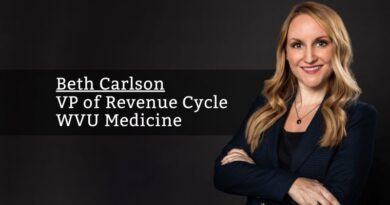Transforming Revenue Cycle Efficiency Through Integrated Leadership
By Katy Ryan Michaud, VP of Revenue Cycle, Franciscan Missionaries of Our Lady Health System
In the post-covid world, revenue cycle teams face unprecedented challenges and opportunities. The industry is evolving rapidly, requiring teams to adapt to changing regulations, technologies, and customer expectations. However, many teams struggle with communication barriers and technological inefficiencies that hinder their performance and innovation. How can revenue cycle teams overcome these obstacles and thrive in the new era?
I’m sharing our journey of discovering a powerful solution: integrated leadership. This strategy involves bringing key personnel from external disciplines, such as IT and operations, into our revenue cycle team. By doing so, we have not only bridged communication gaps but also driven significant improvements in efficiency and shortened the path to innovation.
By combining technical, clinical and operational expertise, we have been able to improve our performance, efficiency, innovation, and customer satisfaction.
The Initial Struggle
Our requests for new features or enhancements often took months to be delivered, as they had to go through multiple layers of approval, testing, and deployment. This meant we were always lagging behind the industry standards and best practices, and missing out on opportunities to optimize our revenue cycle processes.
We often felt that our collaborating IT and Operations teams did not understand our goals, priorities, and pain points, and vice versa. There was a lack of trust and communication between the different disciplines, resulting in silos and conflicts. This made it challenging to coordinate our efforts and achieve our desired outcomes.
Many of the solutions we received from our IT team did not meet our expectations or requirements, as they were based on inaccurate or incomplete information. We frequently encountered errors, bugs, and glitches that affected our workflows and productivity. We also had to deal with frequent system downtimes and maintenance issues that disrupted our operations and customer service.
A New Approach
Recognizing the need for a new approach, we hired an IT analyst and integrated them into our team. This individual would attend all our meetings, gaining a deep understanding of our challenges and providing real-time solutions. The goal was to quickly identify efficiencies and improve communication with the IT team.
The results were immediate and transformative. The embedded analyst quickly uncovered missing context in our IT requests and helped bridge the gap between our needs and the technical solutions. This not only enhanced our team’s expertise but also improved our relationship with the IT department, leading to more efficient builds and higher morale.
We also benefited from having direct access to the analyst’s knowledge and skills. Whenever we encountered a problem or had a question, we could consult the analyst and get an immediate answer or solution. This saved us time and frustration and increased our confidence in using the system. The analyst also helped us optimize our workflows and processes, suggesting best practices and tips that improved our performance and quality.
By hiring an IT analyst and integrating them into our team, we achieved a level of collaboration and alignment that was unprecedented in our organization. We broke down the silos and barriers that had previously hindered our progress and created a culture of trust and mutual support. We were able to deliver better results for our customers and ourselves, thanks to the shared vision and leadership of our team and the analyst.
Expanding the Model
We expanded this model to include hiring a seasoned Operations leader. They helped us bridge the gap between our revenue cycle and clinical teams, creating a more cohesive and collaborative environment. By understanding the needs and challenges of both sides, they facilitated communication and alignment, resulting in smoother workflows and increased customer satisfaction. Their presence also boosted the morale and engagement of our staff, who felt more supported and valued by the organization.
As we integrated the operational leader into our team, we saw a remarkable improvement in our performance and efficiency again. They brought a wealth of clinical knowledge and experience that enabled us to tackle complex issues and devise solutions that met the needs of our customers and stakeholders. They also enhanced our communication and collaboration with the clinical teams, ensuring that our revenue cycle processes were aligned and coordinated with their workflows and objectives.
One of the key benefits of having the operational leader on our team was their ability to foster a culture of innovation and learning. They challenged us to think outside the box and find new ways of improving our revenue cycle processes and outcomes. They also shared their clinical expertise and best practices with us, helping us understand and anticipate the needs and expectations of our customers and partners.
The Benefits of Integrated Leadership
In conclusion, the integrated leadership model has proven to be a valuable asset for our revenue cycle operations. By combining technical, clinical and operational expertise, we have been able to improve our performance, efficiency, innovation, and customer satisfaction. We believe this model is the future of revenue cycle management (RCM) and we look forward to continuing to leverage its benefits. The integrated leadership model has enabled us to achieve remarkable results in our revenue cycle processes. By having leaders with non-traditional skills, we have improved our quality, productivity, creativity, and communication. This model has also enhanced our alignment and collaboration with the external teams, ensuring that we deliver optimal value to our customers and stakeholders. We are confident that this model will help us maintain and strengthen our competitive edge in the market.



